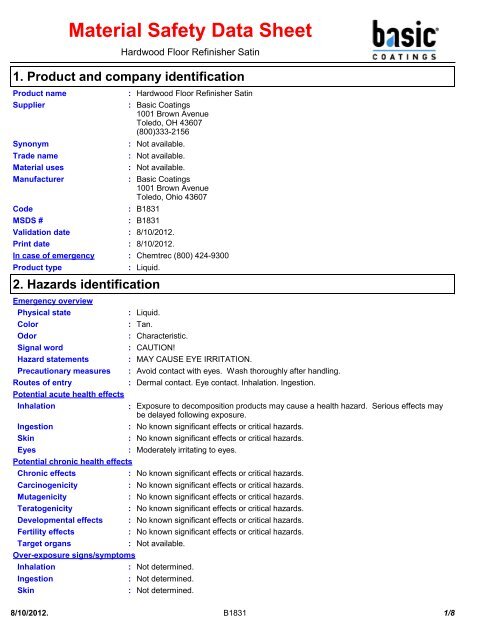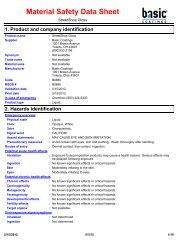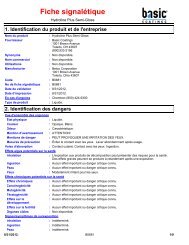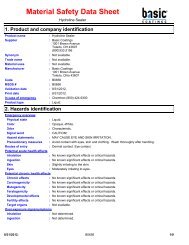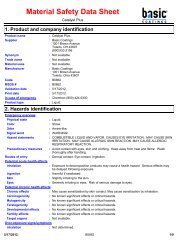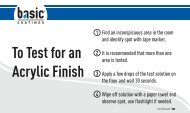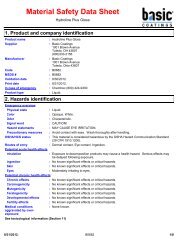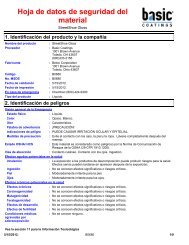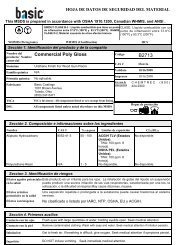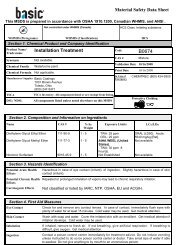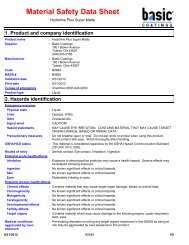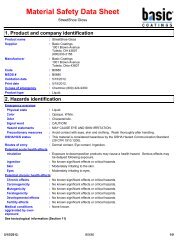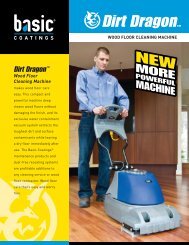B1831 Hardwood Floor Refinisher Satin MSDS ... - Basic Coatings
B1831 Hardwood Floor Refinisher Satin MSDS ... - Basic Coatings
B1831 Hardwood Floor Refinisher Satin MSDS ... - Basic Coatings
You also want an ePaper? Increase the reach of your titles
YUMPU automatically turns print PDFs into web optimized ePapers that Google loves.
Product nameSupplierSynonymTrade nameMaterial usesManufacturerCode<strong>MSDS</strong> #Validation datePrint dateIn case of emergencyMaterial Safety Data Sheet<strong>Hardwood</strong> <strong>Floor</strong> <strong>Refinisher</strong> <strong>Satin</strong>1. Product and company identificationProduct type::::::::::Signal word:Hazard statements ::<strong>Hardwood</strong> <strong>Floor</strong> <strong>Refinisher</strong> <strong>Satin</strong><strong>Basic</strong> <strong>Coatings</strong>1001 Brown AvenueToledo, OH 43607(800)333-2156Not available.Not available.Not available.<strong>Basic</strong> <strong>Coatings</strong>1001 Brown AvenueToledo, Ohio 43607<strong>B1831</strong><strong>B1831</strong>8/10/2012.8/10/2012.Chemtrec (800) 424-9300: Liquid.2. Hazards identificationEmergency overviewPhysical stateColorOdorPrecautionary measuresRoutes of entryPotential acute health effectsInhalation:IngestionSkinEyes:Potential chronic health effectsChronic effectsCarcinogenicityMutagenicityTeratogenicityDevelopmental effectsFertility effects:Liquid.: Tan.: Characteristic.Target organs: Not available.Over-exposure signs/symptomsInhalationIngestionSkinCAUTION!MAY CAUSE EYE IRRITATION.: Avoid contact with eyes. Wash thoroughly after handling.: Dermal contact. Eye contact. Inhalation. Ingestion.::Exposure to decomposition products may cause a health hazard. Serious effects maybe delayed following exposure.No known significant effects or critical hazards.No known significant effects or critical hazards.Moderately irritating to eyes.: No known significant effects or critical hazards.: No known significant effects or critical hazards.: No known significant effects or critical hazards.: No known significant effects or critical hazards.: No known significant effects or critical hazards.: No known significant effects or critical hazards.: Not determined.: Not determined.: Not determined.8/10/2012.<strong>B1831</strong>1/8
<strong>Hardwood</strong> <strong>Floor</strong> <strong>Refinisher</strong> <strong>Satin</strong>2. Hazards identificationEyes: Adverse symptoms may include the following:irritationwateringrednessMedical conditionsaggravated by overexposure:None known.See toxicological information (Section 11)3. Composition/information on ingredientsName CAS number %N-methyl-2-pyrrolidone 872-50-4 1 - 5There are no additional ingredients present which, within the current knowledge of the supplier and in theconcentrations applicable, are classified as hazardous to health or the environment and hence require reporting inthis section.4. First aid measuresEye contactSkin contactInhalationIngestionProtection of first-aidersNotes to physician5. Fire-fighting measuresFlammability of the product :Extinguishing mediaSuitable :Not suitable :Special exposure hazards :Hazardous thermaldecomposition productsSpecial protectiveequipment for fire-fighters::::Check for and remove any contact lenses. Immediately flush eyes with plenty of waterfor at least 15 minutes, occasionally lifting the upper and lower eyelids. Get medicalattention immediately. In case of contact with eyes, rinse immediately with plenty ofwater.In case of contact, immediately flush skin with plenty of water for at least 15 minuteswhile removing contaminated clothing and shoes. Wash clothing before reuse. Cleanshoes thoroughly before reuse. Get medical attention immediately.Move exposed person to fresh air. If not breathing, if breathing is irregular or ifrespiratory arrest occurs, provide artificial respiration or oxygen by trained personnel.Loosen tight clothing such as a collar, tie, belt or waistband. Get medical attentionimmediately.Wash out mouth with water. Do not induce vomiting unless directed to do so by medicalpersonnel. Never give anything by mouth to an unconscious person. Get medicalattention immediately.: No action shall be taken involving any personal risk or without suitable training. It maybe dangerous to the person providing aid to give mouth-to-mouth resuscitation.: In case of inhalation of decomposition products in a fire, symptoms may be delayed.The exposed person may need to be kept under medical surveillance for 48 hours.:In a fire or if heated, a pressure increase will occur and the container may burst.Use an extinguishing agent suitable for the surrounding fire.None known.Promptly isolate the scene by removing all persons from the vicinity of the incident ifthere is a fire. No action shall be taken involving any personal risk or without suitabletraining.: Decomposition products may include the following materials:carbon dioxidecarbon monoxidenitrogen oxidesFire-fighters should wear appropriate protective equipment and self-contained breathingapparatus (SCBA) with a full face-piece operated in positive pressure mode.8/10/2012.<strong>B1831</strong>2/8
<strong>Hardwood</strong> <strong>Floor</strong> <strong>Refinisher</strong> <strong>Satin</strong>5. Fire-fighting measuresSpecial remarks on firehazardsSpecial remarks onexplosion hazards::Not available.Not available.6. Accidental release measuresPersonal precautions :Environmental precautionsMethods for cleaning upNo action shall be taken involving any personal risk or without suitable training.Evacuate surrounding areas. Keep unnecessary and unprotected personnel fromentering. Do not touch or walk through spilled material. Avoid breathing vapor or mist.Provide adequate ventilation. Wear appropriate respirator when ventilation isinadequate. Put on appropriate personal protective equipment (see Section 8).: Avoid dispersal of spilled material and runoff and contact with soil, waterways, drainsand sewers. Inform the relevant authorities if the product has caused environmentalpollution (sewers, waterways, soil or air).Small spill :Large spill :Stop leak if without risk. Move containers from spill area. Dilute with water and mop upif water-soluble. Alternatively, or if water-insoluble, absorb with an inert dry material andplace in an appropriate waste disposal container. Dispose of via a licensed wastedisposal contractor.Stop leak if without risk. Move containers from spill area. Approach release fromupwind. Prevent entry into sewers, water courses, basements or confined areas. Washspillages into an effluent treatment plant or proceed as follows. Contain and collectspillage with non-combustible, absorbent material e.g. sand, earth, vermiculite ordiatomaceous earth and place in container for disposal according to local regulations(see section 13). Dispose of via a licensed waste disposal contractor. Contaminatedabsorbent material may pose the same hazard as the spilled product. Note: see section1 for emergency contact information and section 13 for waste disposal.7. Handling and storageHandlingStorage::Put on appropriate personal protective equipment (see Section 8). Eating, drinking andsmoking should be prohibited in areas where this material is handled, stored andprocessed. Workers should wash hands and face before eating, drinking and smoking.Remove contaminated clothing and protective equipment before entering eating areas.Do not ingest. Avoid contact with eyes, skin and clothing. Avoid breathing vapor or mist.Keep in the original container or an approved alternative made from a compatiblematerial, kept tightly closed when not in use. Empty containers retain product residueand can be hazardous. Do not reuse container.Store in accordance with local regulations. Store in original container protected fromdirect sunlight in a dry, cool and well-ventilated area, away from incompatible materials(see section 10) and food and drink. Keep container tightly closed and sealed until readyfor use. Containers that have been opened must be carefully resealed and kept uprightto prevent leakage. Do not store in unlabeled containers. Use appropriate containmentto avoid environmental contamination.8. Exposure controls/personal protectionOccupational exposure limitsTWA (8 hours) STEL (15 mins) CeilingIngredient List name ppm mg/m³ Other ppm mg/m³ Other ppm mg/m³ Other NotationsN-methyl-2-pyrrolidone ON 7/2010 - 400 - - - - - - -US AIHA 5/2010 10 - - - - - - - - [1][1]Absorbed through skin.Consult local authorities for acceptable exposure limits.Recommended monitoringprocedures: If this product contains ingredients with exposure limits, personal, workplace atmosphereor biological monitoring may be required to determine the effectiveness of the ventilationor other control measures and/or the necessity to use respiratory protective equipment.8/10/2012.<strong>B1831</strong>3/8
<strong>Hardwood</strong> <strong>Floor</strong> <strong>Refinisher</strong> <strong>Satin</strong>8. Exposure controls/personal protectionEngineering measuresHygiene measuresPersonal protectionRespiratoryHands :EyesSkinEnvironmental exposurecontrolsOther protectionPersonal protectiveequipment (Pictograms): No special ventilation requirements. Good general ventilation should be sufficient tocontrol worker exposure to airborne contaminants. If this product contains ingredientswith exposure limits, use process enclosures, local exhaust ventilation or otherengineering controls to keep worker exposure below any recommended or statutorylimits.: Wash hands, forearms and face thoroughly after handling chemical products, beforeeating, smoking and using the lavatory and at the end of the working period. Appropriatetechniques should be used to remove potentially contaminated clothing. Washcontaminated clothing before reusing. Ensure that eyewash stations and safety showersare close to the workstation location.::::Use a properly fitted, air-purifying or air-fed respirator complying with an approvedstandard if a risk assessment indicates this is necessary. Respirator selection must bebased on known or anticipated exposure levels, the hazards of the product and the safeworking limits of the selected respirator.Chemical-resistant, impervious gloves complying with an approved standard should beworn at all times when handling chemical products if a risk assessment indicates this isnecessary. 200°C (>392°F) [Product does not sustain combustion.]:: Not applicable.: Not available.: Not available.: Tan.:::::::::Not applicable.Characteristic.Not available.Not applicable.Not applicable.7.5 to 8.5Not available.Not available.Not available.1.04656<strong>B1831</strong>4/8
<strong>Hardwood</strong> <strong>Floor</strong> <strong>Refinisher</strong> <strong>Satin</strong>9. Physical and chemical propertiesVapor pressureVapor densityVolatilityOdor thresholdEvaporation rateSADTViscosityIonicity (in water)Dispersibility propertiesSolubilityPhysical/chemicalproperties comments::::Not available.Not available.Not available.Not available.: Not available.: Not available.:::::Not available.Not available.Not available.Partially soluble in the following materials: cold water.Not available.10. Stability and reactivityChemical stabilityConditions to avoidIncompatible materialsHazardous decompositionproductsPossibility of hazardousreactions::::The product is stable.No specific data.No specific data.Under normal conditions of storage and use, hazardous decomposition products shouldnot be produced.: Under normal conditions of storage and use, hazardous reactions will not occur.11. Toxicological informationAcute toxicityProduct/ingredient name Result Species Dose ExposureN-methyl-2-pyrrolidone LD50 Dermal Rabbit 8 g/kg -LD50 Oral Rat 3914 mg/kg -Conclusion/SummaryChronic toxicityNot available.Conclusion/SummaryIrritation/Corrosion: Not available.: Not available.Product/ingredient name Result Species Score Exposure ObservationN-methyl-2-pyrrolidone Eyes - Moderate irritant Rabbit - 100milligrams-Conclusion/SummarySensitizerNot available.Conclusion/SummaryCarcinogenicityNot available.Conclusion/SummaryClassificationNot available.: Not available.: Not available.: Not available.Mutagenicity8/10/2012.<strong>B1831</strong>5/8
<strong>Hardwood</strong> <strong>Floor</strong> <strong>Refinisher</strong> <strong>Satin</strong>11. Toxicological informationNot available.Conclusion/SummaryTeratogenicityNot available.Conclusion/SummaryReproductive toxicityNot available.: Not available.: Not available.Conclusion/Summary : Not available.Synergistic products : Not available.12. Ecological informationEcotoxicityAquatic ecotoxicity: No known significant effects or critical hazards.Product/ingredient nameResultSpeciesN-methyl-2-pyrrolidone Acute LC50 1.23 ppm Fresh water Daphnia - Daphnia magna -
<strong>Hardwood</strong> <strong>Floor</strong> <strong>Refinisher</strong> <strong>Satin</strong>14. Transport informationRegulatoryinformationDOT ClassificationUN numberProper shippingname- - --TDG Classification Not- --regulated.MexicoClassificationNotregulated.Notregulated.ADR/RID Class Not- - -regulated.IMDG Class Not- - -regulated.IATA-DGR Class Not--regulated.PG* : Packing group15. Regulatory informationUnited States inventory(TSCA 8b)WHMIS (Canada)Canadian listsClasses PG* Label Additionalinformation- - - -Not controlled under WHMIS (Canada).Canadian NPRI : The following components are listed: N-Methyl-2-pyrrolidoneCEPA Toxic substances : None of the components are listed.International regulationsInternational lists:Canada inventory: Not determined.This product has been classified in accordance with the hazard criteria of the Controlled Products Regulationsand the <strong>MSDS</strong> contains all the information required by the Controlled Products Regulations.Chemical WeaponsConvention List Schedule IChemicalsChemical WeaponsConvention List ScheduleII ChemicalsChemical WeaponsConvention List ScheduleIII Chemicals: Not determined.:Australia inventory (AICS): Not determined.China inventory (IECSC): Not determined.Japan inventory: Not determined.Korea inventory: Not determined.New Zealand Inventory of Chemicals (NZIoC): Not determined.Philippines inventory (PICCS): Not determined.: Not listed: Not listed: Not listed-----8/10/2012.<strong>B1831</strong>7/8
<strong>Hardwood</strong> <strong>Floor</strong> <strong>Refinisher</strong> <strong>Satin</strong>16. Other informationLabel requirements :Hazardous Material:Information System (U.S.A.)MAY CAUSE EYE IRRITATION.HealthFlammabilityPhysical hazards210Caution: HMIS® ratings are based on a 0-4 rating scale, with 0 representing minimal hazards or risks, and 4representing significant hazards or risks Although HMIS® ratings are not required on <strong>MSDS</strong>s under 29 CFR1910.1200, the preparer may choose to provide them. HMIS® ratings are to be used with a fully implementedHMIS® program. HMIS® is a registered mark of the National Paint & <strong>Coatings</strong> Association (NPCA). HMIS®materials may be purchased exclusively from J. J. Keller (800) 327-6868.The customer is responsible for determining the PPE code for this material.ReferencesOther specialconsiderationsDate of printingDate of issueDate of previous issueVersionPrepared byNotice to reader:::::Not available.Not available.8/10/2012.8/10/2012.No previous validation.: 0.01: Not available.Indicates information that has changed from previously issued version.To the best of our knowledge, the information contained herein is accurate. However, neither the above-namedsupplier, nor any of its subsidiaries, assumes any liability whatsoever for the accuracy or completeness of theinformation contained herein.Final determination of suitability of any material is the sole responsibility of the user. All materials may presentunknown hazards and should be used with caution. Although certain hazards are described herein, we cannotguarantee that these are the only hazards that exist.8/10/2012.<strong>B1831</strong>8/8


